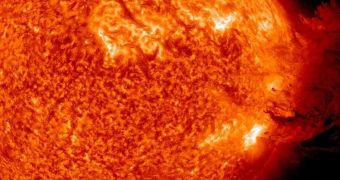According to the conclusions of a new simulation conducted by NASA experts, it would appear that solar storms – and the coronal mass ejections (CME) they produce – are enough to literally erode the lunar surface. This primarily happens because the Moon has no protective atmospheric layers.
The discovery again highlights the critical importance of a global magnetic field, as well as a magnetosphere. These are the most important defenses a planet has against solar winds and radiations coming from both the Sun and deep space.
At the same time, it could be that a mechanism similar to the one hinted to exist on the Moon is also at work in the case of planets such as Mars. As all other objects without magnetic fields, they too lose a great deal of surface material to solar winds.
The investigation was conducted by a team of experts from the NASA Lunar Science Institute's (LSI) Dynamic Response of the Environment At the Moon (DREAM) team. The group was led by Rosemary Killen, a scientist from the NASA Goddard Space Flight Center (GSFC), in Greenbelt, Maryland.
One of the most important things to remember about the Moon is that it's surrounded by an exosphere. This means that the layer of gaseous chemicals covering its surface is so thin it cannot even be called an atmosphere.
It therefore stands to reason that it would provide no protection whatsoever against a CME made up of as much as a billion tons of plasma. The material would be traveling in a cloud that would exceed the diameter of Earth several times over, and would move at speeds reaching 1 million miles per hour.
When CME plasma reaches our natural satellite, it zips through the exosphere and impacts the surface directly. A process called sputtering then occurs, which sees atoms being stripped off the material making up the lunar surface, and get carried into space.
“We found that when this massive cloud of plasma strikes the Moon, it acts like a sandblaster and easily removes volatile material from the surface,” NASA investigator William Farrell explains.
“The model predicts 100 to 200 tons of lunar material – the equivalent of 10 dump truck loads – could be stripped off the lunar surface during the typical 2-day passage of a CME,” adds the GSFC scientist, who is the leader of the DREAM team.
Details of the new investigation were published in a special issue of the esteemed scientific Journal of Geophysical Research Planets. When the NASA Lunar Atmosphere And Dust Environment Explorer (LADEE) mission launches in 2013, this simulation will be put to the test.
“This huge CME sputtering effect will make LADEE almost like a surface mineralogy explorer, not because LADEE is on the surface, but because during solar storms surface atoms are blasted up to LADEE,” Farrell concludes.

 14 DAY TRIAL //
14 DAY TRIAL //